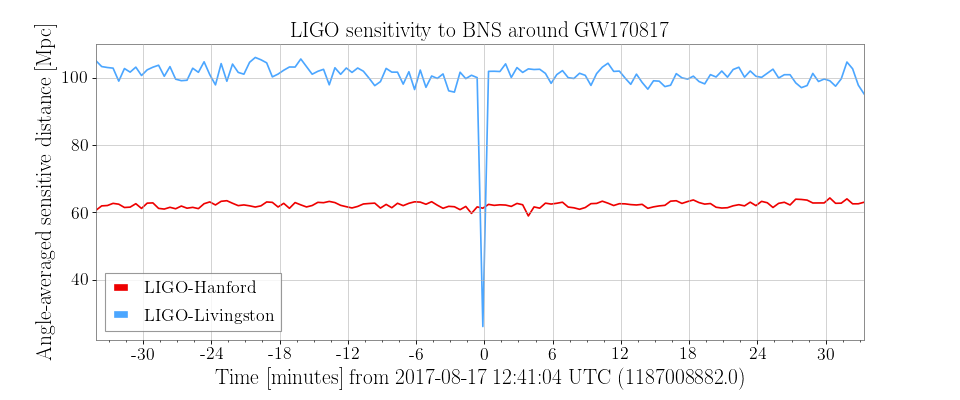1. Generating an inspiral range timeseries¶
One standard figure-of-merit for the sensitivity of a gravitational-wave
detector is the distance to which a binary neutron star (BNS) inspiral
with two 1.4 solar mass components would be detected with a signal-to-noise
ratio (SNR) of 8. We can estimate this using
gwpy.astro.range_timeseries() directly from the strain readout for
a detector.
First, we need to load some data. We can fetch the
public data
around the GW170817 BNS merger:
from gwpy.timeseries import TimeSeries
h1 = TimeSeries.fetch_open_data('H1', 1187006834, 1187010930, tag='C02')
l1 = TimeSeries.fetch_open_data('L1', 1187006834, 1187010930, tag='C02')
Then, we can measure the inspiral range directly:
from gwpy.astro import range_timeseries
h1range = range_timeseries(h1, 30, fftlength=4, fmin=10)
l1range = range_timeseries(l1, 30, fftlength=4, fmin=10)
We can now plot these trends to see the variation in LIGO sensitivity over an hour or so surrounding GW170817:
plot = h1range.plot(
label='LIGO-Hanford', color='gwpy:ligo-hanford', figsize=(12, 5))
ax = plot.gca()
ax.plot(l1range, label='LIGO-Livingston', color='gwpy:ligo-livingston')
ax.set_ylabel('Angle-averaged sensitive distance [Mpc]')
ax.set_title('LIGO sensitivity to BNS around GW170817')
ax.set_epoch(1187008882) # <- set 0 on plot to GW170817
ax.legend()
plot.show()
(png)

Note, the extreme dip in LIGO-Livingston’s sensitivity near GW170817 is caused by a loud, transient noise event, see Phys. Rev. Lett. vol. 119, p. 161101 for more information.